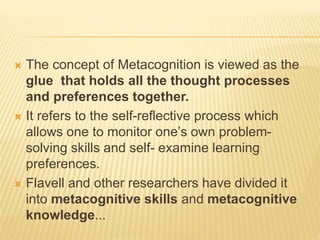Metacognitive strategies
- 2. Most powerful predictors of learning ïķis â thinking about thinkingâ, âknowing what we knowâ and âwhat we donât knowâ. ïķregulates cognitive activity but at the same time needs cognitive activity as vehicle. Metacognition www.dailynews.com THE TEACHERSâ MAGAZINE -July 28, 2014
- 4. ïRefers to the methods used to help students understand the way they learn; are processes designed for students to âthinkâ about their âthinkingâ
- 5. ïTeachers who use metacognitive strategies can positively impact students who have learning disabilities by helping them to develop an APPROPRIATE plan for learning information, which can be memorized and can be an eventual routine...
- 6. The basic metacognitive strategies Connecting new information to former knowledge. Planning, monitoring and evaluating thinking processes Selecting thinking strategies deliberately
- 7. Before beginning a task âĒ Set goals; plan the content sequence âĒ Choose strategies While working on a task âĒ Check the on the task âĒ Check the comprehension âĒ Check the production After completing the task âĒ Assess how well you have accomplish the task âĒ How well you have used the learning strategies âĒ Identify changes to be make next time Process Flow Plan/Organize Monitor Evaluate
- 9. â A THINKING PERSON IS IN CHARGE OF HER BEHAVIORâ
- 10. âĒShe determines when it is necessary to use metacognitive strategies. âĒShe selects strategies to define a problem situation and researches alternative solutions âĒShe tailors this research for information to constraints time and energy. âĒShe monitors, controls and judges her thinking. Teachers Question and Answer Portion WORLD EXCLUSIVES THE Teachersâ Magazine â A THINKING PERSON IS IN CHARGE OF HER BEHAVIORâ
- 11. - Learning how to learn, developing a repertoire of thinking processes which can be applied to solve problems is the Major Goal of Education
- 13. ï The concept of Metacognition is viewed as the glue that holds all the thought processes and preferences together. ï It refers to the self-reflective process which allows one to monitor oneâs own problem- solving skills and self- examine learning preferences. ï Flavell and other researchers have divided it into metacognitive skills and metacognitive knowledge...
- 14. ï It is this self-knowledge that is the Goal of the Undergraduate Programs everywhere since it implies not just the â Learning of Thingsâ but â Learning how to learnâ which is essential to the goal of âlifelong learningâ














